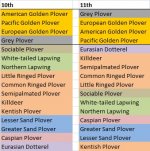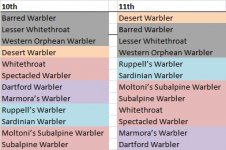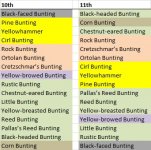It's forward to the past for the genera of Gulls, Wood-warblers and Finches, at least, if BOU adopt Birdlife taxonomy. I wonder if BBRC will automatically follow the BOU if Birdlife taxonomy is the norm?
Personally I'd like to see what BTO will do - their
stated position is they follow BOU so presumably they will again change to a new order? I appreciate the main interest of this forum is taxonomies per se, and resulting splits, but to me as bird recorder one of my prime concerns is species orders, as used in our local bird reports, bird atlases, etc; we have religiously followed BOU thus far, resulting in a multiplicity of sequences and I think now achieving a state of confusion for many "ordinary" birders trying to look things up in different publications. Indeed we have still not finalised the sequence for our own local atlas (South-east Scotland 2007-2013) due to be published next year, and the possibility looms of another period of rapid change/total upheaval of orders - indeed also some species definitions, e.g. I have written ~10k words on Hooded Crow, and hybrids thereof, for our long accounts (electronic, only "short" accounts in the published book) but if we don't get a move on that will not merit a species account any more!
I've had a look at
BirdLife 8.0 and I see that in layman's terms the overall sequence of Orders runs Gamebirds, Wildfowl, Grebes, Flamingos, Pigeons, Nightjars/Swifts, Cuckoos, Rails/Cranes, Bustards, Divers, Petrels etc, Storks, Ibis/Herons, Gannets/Cormorants, Waders/Gulls/Terns/Skuas/Auks, Owls, Hawks/Eagles, Bee-eater/Roller/Kingfisher, Woodpeckers, Falcons, Passerines. Roughly, but whatever, pretty different to what we currently have, even with the recent move of Falcons. I note the bold statement there that "The BirdLife Taxonomic Checklist is currently in a transitional phase", and comments mentioned by Richard that they are due to follow suit in applying a revised taxonomic approach to passerines, "which will be incorporated into a revised BirdLife Taxonomic Checklist in due course" - so not necessarily in time for our atlas next year!
I'm surprised at the apparent lack of debate on this subject, i.e. species orders. Though I have found the odd person who agrees with me (in private) that forcing all of our publications to follow the constantly changing taxonomic sequences, produced by those studying taxonomy for their own purposes, is not practical for making accessible publications for wider readership, but it seems the consensus position is our publications should all follow the latest scientific understanding. Of course the counter-argument is always, what else would you do, how can you justify going back to a poorer understanding of taxonomic sequence? I agree it's a Hobson's choice, but any baseline could be chosen, even back to Voous/EURING, along with an open declaration that it is simply
an order and does not necessarily reflect the latest scientific understanding of the sequence...









